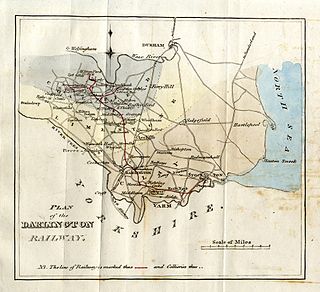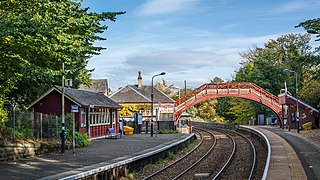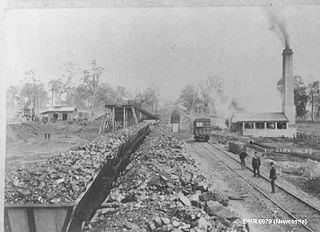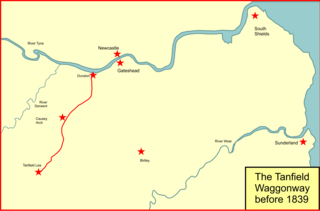Related Research Articles

The Stockton and Darlington Railway (S&DR) was a railway company that operated in north-east England from 1825 to 1863. The world's first public railway to use steam locomotives, its first line connected collieries near Shildon with Darlington and Stockton in County Durham, and was officially opened on 27 September 1825. The movement of coal to ships rapidly became a lucrative business, and the line was soon extended to a new port at Middlesbrough. While coal waggons were hauled by steam locomotives from the start, passengers were carried in coaches drawn by horses until carriages hauled by steam locomotives were introduced in 1833.

The North Tyneside Steam Railway and Stephenson Steam Railway are visitor attractions in North Shields, North East England. The museum and railway workshops share a building on Middle Engine Lane adjacent to the Silverlink Retail Park. The railway is a standard gauge line, running south for 2 miles (3.2 km) from the museum to Percy Main. The railway is operated by the North Tyneside Steam Railway Association (NTSRA). The museum is managed by Tyne and Wear Archives and Museums on behalf of North Tyneside Council.

The Maryport & Carlisle Railway (M&CR) was an English railway company formed in 1836 which built and operated a small but eventually highly profitable railway to connect Maryport and Carlisle in Cumberland, England. There were many small collieries in the area and efficient access to the harbour at Maryport was important.

Wetheral is a railway station on the Tyne Valley Line, which runs between Newcastle and Carlisle via Hexham. The station, situated 4 miles 7 chains east of Carlisle, serves the villages of Great Corby and Wetheral, City of Carlisle in Cumbria, England. It is owned by Network Rail and managed by Northern Trains.

Brampton (Cumbria) is a railway station on the Tyne Valley Line, which runs between Newcastle and Carlisle via Hexham. The station, situated 10 miles 62 chains (10.8 mi; 17.3 km) east of Carlisle, serves the hamlet of Milton and the town of Brampton, Cumberland in Cumbria, England. It is owned by Network Rail and managed by Northern Trains.

The Belmont railway line is an abandoned coal haulage and passenger rail line from Adamstown, New South Wales to Belmont, New South Wales. This was a private railway, being the property of the New Redhead Estate and Coal Company and was generally known as the Belmont Branch. The line closed in December 1991. It has since been converted into a cycleway or rail trail - The Fernleigh Track.

Over the latter years of the 19th and early years of the 20th centuries, Penistone in Yorkshire gained a name as an accident black-spot on Britain's railway network; indeed, it could be said to hold the title of the worst accident black-spot in the country. The main line through the town was the Woodhead route of the Manchester, Sheffield and Lincolnshire Railway between Sheffield Victoria and Manchester, London Road. The line was heavily graded with a summit some 400 yards inside the eastern portal of the Woodhead tunnel.

Torquay railway station is on the Riviera Line and serves the seaside resort of Torquay, Devon, England. It is 219 miles 79 chains (354 km) from London Paddington.
The Blyth and Tyne Railway was a railway company in Northumberland, England, incorporated by act of Parliament on 30 June 1852. It was created to unify the various private railways and waggonways built to carry coal from the Northumberland coalfield to Blyth and the River Tyne, which it took control of on 1 January 1853. Over time, the railway expanded its network to reach Morpeth (1857/8), North Seaton (1859), Tynemouth (1860/1), Newcastle upon Tyne (1864), and finally Newbiggin-by-the-Sea (1872). It became part of the much larger North Eastern Railway in 1874.
The Ballochney Railway was an early railway built near Airdrie, North Lanarkshire, Scotland. It was intended primarily to carry minerals from coal and ironstone pits, and stone quarries, in the area immediately north and east of Airdrie, to market, predominantly over the adjoining Monkland and Kirkintilloch Railway. Passengers were carried later.

The South Maitland Railway was once an extensive network of privately owned colliery and passenger railway lines which served the South Maitland coalfields in the Hunter Region of New South Wales, Australia and were the second last system in Australia to use steam haulage, having used steam locomotives until 1983.

Hallbankgate is a village in Cumbria, England, 13 miles (21 km) east of Carlisle. A former coal and lead mining village, it straddles the A689 Brampton to Alston road. Limestone is quarried here and it once had a gasworks and a forge. The village has a primary school, a village shop and tea room and a pub. There are three other hamlets in the civil parish, Farlam, Kirkhouse and Tindale.

The Richmond Vale Railway was a 4 ft 8+1⁄2 in colliery railway line in the Hunter Valley of New South Wales, Australia, servicing coal mines at Minmi, Stockrington, Pelaw Main and Richmond Main. It was over 26 km (16 mi) long and passed through three tunnels, and was the last commercially operated railway in Australia to use steam locomotives.
The Stanhope and Tyne Railway was an early British mineral railway that ran from Stanhope to South Shields at the mouth of the River Tyne in County Durham, England. It ran through the towns of Birtley, Chester Le Street, West Stanley and Consett. The object was to convey limestone from Stanhope and coal from West Consett and elsewhere to the Tyne, and to local consumers. Passengers were later carried on parts of the line.

The Tyne Valley Line is a 58-mile (93 km) route, linking Newcastle upon Tyne with Hexham and Carlisle, England. The line follows the course of the River Tyne through Tyne and Wear and Northumberland. Five stations and two viaducts on the route are listed structures.
The Brampton Railway was a mineral railway built in 1798 to bring coal from workings on Tindale Fell to staiths at Brampton. It was a development of short sections of earlier wooden railways.

Tindale or Tindale Fell is a hamlet in the parish of Farlam in the City of Carlisle district of the English county of Cumbria. It is to the south of the A689 Brampton to Alston road. It is a former mining village – both coal and lead were mined here. Limestone was quarried here.

The Brandling Junction Railway was an early railway in County Durham, England. It took over the Tanfield Waggonway of 1725 that was built to bring coal from Tanfield to staiths on the River Tyne at Dunston. The Brandling Junction Railway itself opened in stages from 1839, running from Gateshead to Wearmouth and South Shields. Wearmouth was regarded at the time as the "Sunderland" terminal.

The Newcastle & Carlisle Railway (N&CR) was an English railway company formed in 1825 that built a line from Newcastle upon Tyne on Britain's east coast, to Carlisle, on the west coast. The railway began operating mineral trains in 1834 between Blaydon and Hexham, and passengers were carried for the first time the following year. The rest of the line opened in stages, completing a through route between Carlisle and Gateshead, south of the River Tyne in 1837. The directors repeatedly changed their intentions for the route at the eastern end of the line, but finally a line was opened from Scotswood to a Newcastle terminal in 1839. That line was extended twice, reaching the new Newcastle Central Station in 1851.
Several mineral railways were constructed around Dunfermline in western Fife, Scotland, in the eighteenth century and later. Their purpose was to convey minerals to market from the outcropping coal deposits that had encouraged industrial activity in the area from an early date.
References
- ↑ The Times; 14 December 1836.